|
For information about H1N1, visit Fermilab's flu information site.
|
|
Thursday, Dec. 3
- Breakfast: Apple sticks
- Southwestern chicken tortilla
- Philly-style cheese steak
- Garlic herb-roasted pork
- Mardi Gras jambalaya
- Southwestern turkey wrap
- Assorted slices of pizza
- Marinated grilled chicken Caesar salad
Wilson Hall Cafe Menu |
|
Thursday, Dec. 3
Dinner
- Mushroom duxelle
- Duck breast with lingonberry sauce
- Wild rice
- Brussels sprouts
- German apple cake
Wednesday, Dec. 9
Lunch
- Salmon Wellington
- Parmesan orzo
- Lemon pound cake with blueberry sauce
Chez Leon Menu
Call x3524 to make your reservation.
|
|
|
ATLAS' countdown to collisions
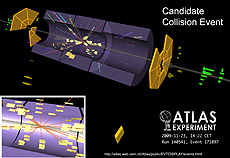 |
| First 900 GeV candidate collision events in the ATLAS detector on Nov. 23, 2009. |
ATLAS, at 148 feet long, 82 feet high, and 82 feet wide, has the largest volume of any particle detector ever built and is designed to study the products of high-energy proton-proton collisions. Over the past year, ATLAS has been upgrading, repairing, and preparing for LHC collisions, which began on Monday, November 23, 2009. In the four months preceding the first collisions, the ATLAS collaboration's focus shifted from repair and installation work to getting all pieces of the complex ATLAS detector operating as one. Here's a look at how ATLAS prepared for collisions.
First, a checkup - four months until collisions
When the ATLAS detector is closed up and ready for beam, the innermost portions are inaccessible. Therefore, much attention is paid to infrastructure maintenance when the commissioning process begins. ATLAS' Luca Fiorini explained, "The detector is built like a Russian doll. There are things that we cannot repair once the cavern is closed and the magnets are on, though there are still outer levels that we can work on."
Several weeks over the summer were devoted to maintenance work on ATLAS' 12 sub-detector units and their internal components. Infrastructure maintenance occurred on all three levels of ATLAS: the inner detector, calorimeters, and muon chambers, to be sure that no wires were crossed and all detector channels were calibrated to work together.
Read more
— Daisy Yuhas |
Tesla coil enthusiasts: Danger and drama part of allure
From the Chicago Tribune, Dec. 2, 2009
Editor's note: Fermilab employees Jeff Larson and Steve Ward are featured in this article.
Under a starry Saturday sky behind a Lake Zurich warehouse, three men unload a small flamethrower, electric cabling, neon-tube "light sabers," about 80 pounds of chain mail and two 7-foot devices that look like monster-movie props. Terry Blake, 48, Jeff Larson, 39, and Steve Ward, 24, call themselves the Masters of Lightning and are members of a small sect within the hobbyist world: Tesla coil enthusiasts. Their coils -- which generate beautiful, lethal electrical sparks up to 12 feet long -- are a much-modified version of the device Nikola Tesla invented to wirelessly transport electricity.
Read more
|
Cable fault temporarily
shuts down LHC
The Large Hadron Collider was shut down at 1:23 a.m. (Geneva time) when a cable fault caused a failure in the 18-kilovolt power supply network. The network was back up by 10:30 a.m., according to CERN communicators.
The operations team at CERN is working on getting all parts of the LHC accelerator chain back up and running. Power cuts are a routine cause for down-time for particle accelerators, so the team was prepared for such a scenario.
A short circuit due to faulty insulation affected mainly the section of the CERN site in Meyrin, Switzerland, which houses the injectors and the main computing center but not LHC cryogenics. This means that the team does not need to undergo the lengthy process of cooling the magnets back to operating temperature before they can bring beam back to the machine.
Update 6:17 a.m. (Geneva time) Dec.3: Beam was back in the LHC at 10:15 p.m. last night. The operations team is back to testing and measuring beams at 450 GeV.
Read more stories on symmetry breaking
Read an article from Scientific American
— Kathryn Grim
|
University of Mississippi
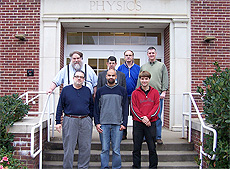 |
| Back row, from left: Don Summers, David Sanders, Rob Kroeger and Breese Quinn. Front row, from left: Lucien Cremaldi, Sudeep Bhatia and Peter Sonnek. |
NAME:
University of Mississippi
NICKNAME:
Ole Miss
HOME TOWN:
Oxford, Miss.
MASCOT:
Rebels
SCHOOL COLORS:
Red and Blue
PARTICLE PHYSICS COLLABORATIONS:
Currently DZero, CMS, BaBar, MICE and the proposed MuCool, neutrino factory and muon collider.
EXPERIMENTS AT FERMILAB:
DZero, CMS, MuCool, E791, past E769 and E691
 |
| From left: Terry Hart, MICE and APC; Lalith Perera, CMS; and Alex Melnitchouk, DZero. Not pictured: Rahmat Rahmet, CMS |
SCIENTISTS AND STUDENTS AT FERMILAB:
Four faculty, one scientist, four postdocs and two students
COLLABORATING AT FERMILAB SINCE:
1988
MAJOR CONTRIBUTIONS:
Cherenkov and Muon PID counters for charm and semileptonic studies (Fermilab Tagged Photon Lab and MICE). First UNIX computing farms and first acquisition system (E791) to write 10 megabytes per second to tape. Leadership roles in Silicon Microstrip Tracker construction, commissioning, software, operation, and W mass measurement (DZero). HCAL calorimeter contributions and GFLASH simulations, pixel cooling and controls (CMS). Upgrade path to accelerate leptons to 750 GeV in the Tevatron tunnel for use in the proposed MuCool, neutrino factory and muon collider experiments. The UEC Government Relations chair from Ole Miss organized more than 500 meetings with Congress and executive branch spanning the start of DOE Office of Science and NSF budget doubling.
PARTICLE PHYSICS RESEARCH FOCUS:
Electroweak and heavy flavor studies
WHAT SETS PARTICLE PHYSICS AT THE UNIVERSITY OF MISSISSIPPI APART?
Pioneering efforts in UNIX computing in high-energy physics, high-speed data acquisition and large data set reconstruction and Monte Carlo generation with offsite university farms.
FUNDING AGENCY:
Department of Energy and National Science Foundation.
FAVORITE NATIONAL LABORATORY:
Fermilab!

View all University profiles |
|
|
The Higgs boson juggernaut
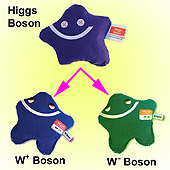 |
| If the Higgs boson’s mass is high, it is expected to decay predominantly into two W bosons. Plushies images from the Particle Zoo. |
There are a lot of types of discoveries. There's the unexpected money you find in the pocket of a coat you haven't worn since last winter, or the pair of Manolo Blahnik's you find at the local Goodwill. These kinds of discoveries give you a quick and unexpected thrill.
Then there are the discoveries that require an enormous amount of time and focused effort. If we ever find the Higgs boson, the discovery will be of this type. We physicists won't find a single specific collision for which the clouds part and a single ray of light shines down on a Higgs boson lying on a velvet pillow.
DZero physicists have just released their most recent results in the ongoing search for the Higgs boson, which physicists believe is the source of mass for all subatomic particles. This is an update of the results of last spring when an analysis combining both DZero and CDF data first ruled out some possible Higgs boson masses.
This particular analysis uses improved techniques, and in some cases nearly double the data, to look for a type of Higgs boson decay, specifically into two W bosons. This decay mode is relatively easy to identify. If the Higgs boson is heavy, this will be the boson's dominant decay mode.
The most accurate Higgs measurement requires combining DZero and CDF results. When we combined DZero's data with CDF's equivalent current analysis, the region of excluded Higgs boson masses actually got a bit smaller than before. This result seems counterintuitive and is a matter of probability. If you flip a coin 10 times, you might expect five results to be heads. In this case, DZero's earlier result was like flipping a coin 10 times and getting three heads. With double the data, it is as if we flipped the coin 20 times and got 13 heads. In neither case did we get 50 percent heads, yet both outcomes are perfectly likely and, as we increase our data, the fluctuations decrease.
The important things are that we have nearly doubled our data, substantially improved our analysis techniques that our uncertainties have shrunk, and that the Higgs juggernaut rolls on. If the Higgs is there, with enough time, cleverness and Tevatron-supplied beam, we'll find it.
— Don Lincoln
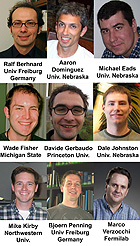 |
The Higgs boson analyses are among the most challenging undertaken by DZero. These physicists have brought together the tools generated by the entire collaboration to attack this problem. |
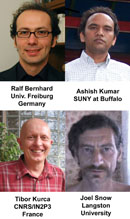 |
Modern particle physics analyses rely heavily on simulations. These physicists lead DZero’s simulated event production effort. |
|
Statement on Japanese science funding by KEK Director General Atsuto Suzuki
From Interactions.org, Dec. 2, 2009
In response to the prospect of severe budget cuts for Japanese science research, Dr. Atsuto Suzuki, Director General of Japan's High Energy Accelerator Research Organization, or KEK, this week issued the following statement and put out a call for opinions from the worldwide scientific community:
The research program at High Energy Accelerator Research Organization (KEK) is facing a grave possibility of a severe budget cut, as recommended by the recently issued Public Budget Review by Japanese government. This affects Japanese renowned research programs including the ones hosted by KEK, such as elementary particle physics and related fields in astrophysics, material and life sciences. More than 260 universities and laboratories attend these programs. I would like to take this opportunity to explain to you what KEK is doing to enhance its research and education programs, and also would like to solicit your opinions.
Read more
|
|